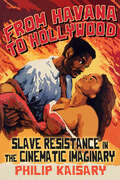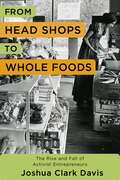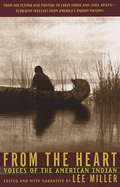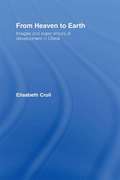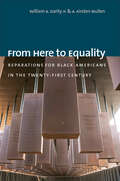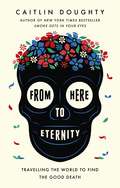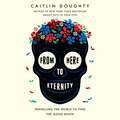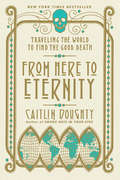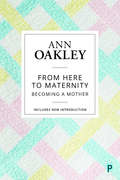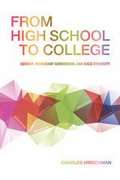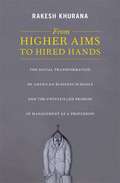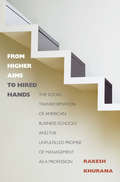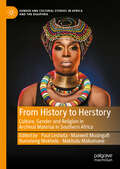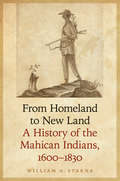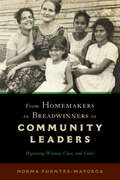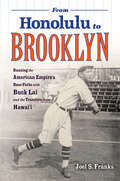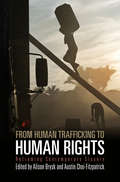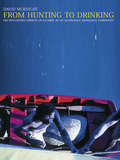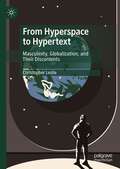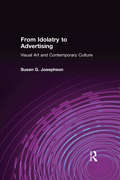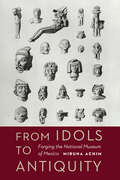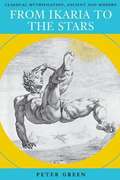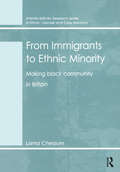- Table View
- List View
From Havana to Hollywood: Slave Resistance in the Cinematic Imaginary (SUNY series, Afro-Latinx Futures)
by Philip KaisaryFrom Havana to Hollywood examines the presence or absence of Black resistance to slavery in feature films produced in either Havana or Hollywood—including Gillo Pontecorvo's Burn!, neglected masterpieces by Cuban auteurs Tomás Gutiérrez Alea and Sergio Giral, and Steve McQueen's Oscar-winning 12 Years a Slave. Philip Kaisary argues that, with rare exceptions, the representation of Black agency in Hollywood has always been, and remains, taboo. Contrastingly, Cuban cinema foregrounds Black agency, challenging the ways in which slavery has been misremembered and misunderstood in North America and Europe. With powerful, richly theorized readings, the book shows how Cuban cinema especially recreates the past to fuel visions of liberation and asks how the medium of film might contribute to a renewal of emancipatory politics today.
From Head Shops to Whole Foods: The Rise and Fall of Activist Entrepreneurs (Columbia Studies in the History of U.S. Capitalism)
by Joshua DavisIn the 1960s and ’70s, a diverse range of storefronts—including head shops, African American bookstores, feminist businesses, and organic grocers—brought the work of the New Left, Black Power, feminism, environmentalism, and other movements into the marketplace. Through shared ownership, limited growth, and democratic workplaces, these activist entrepreneurs offered alternatives to conventional profit-driven corporate business models. By the middle of the 1970s, thousands of these enterprises operated across the United States—but only a handful survive today. Some, such as Whole Foods Market, have abandoned their quest for collective political change in favor of maximizing profits.Vividly portraying the struggles, successes, and sacrifices of these unlikely entrepreneurs, From Head Shops to Whole Foods writes a new history of social movements and capitalism by showing how activists embraced small businesses in a way few historians have considered. The book challenges the widespread but mistaken idea that activism and political dissent are inherently antithetical to participation in the marketplace. Joshua Clark Davis uncovers the historical roots of contemporary interest in ethical consumption, social enterprise, buying local, and mission-driven business, while also showing how today’s companies have adopted the language—but not often the mission—of liberation and social change.
From The Heart
by Lee MillerExcerpts from Native American speeches--by Moctezuma, Tecumseh, Cochise, Sitting Bull, and others--accompanied by commentary by non-Indian observers, provide an eloquent overview of five hundred years of fateful encounters between Europeans and Native Americans. Reprint. AB.
From Heaven to Earth: Images and Experiences of Development in China
by Elizabeth CrollMuch has been written of China's peasant revolution, less has been written on the peasant experience of reform. In From Heaven to Earth Elisabeth Croll examines the images, policies and experiences of development and links the peasants' experience of revolution and reform with their conceptualisations of time and change and examines the new and recent desires which motivate peasant households in China; the new and strenuous demands which are generated by current reforms which allocate new responsibilities to the peasant family; and family strategies evolved by peasant housholds to maximise their resources within the context of reformed rural development. From Heaven to Earth will be of great interest to students, lecturers and professionals in development studies, anthropology, sociology and Chinese Studies.
From Here to Equality: Reparations for Black Americans in the Twenty-First Century
by William A. Darity A. Kirsten MullenRacism and discrimination have choked economic opportunity for African Americans at nearly every turn. At several historic moments, the trajectory of racial inequality could have been altered dramatically. Perhaps no moment was more opportune than the early days of Reconstruction, when the U.S. government temporarily implemented a major redistribution of land from former slaveholders to the newly emancipated enslaved. But neither Reconstruction nor the New Deal nor the civil rights struggle led to an economically just and fair nation. Today, systematic inequality persists in the form of housing discrimination, unequal education, police brutality, mass incarceration, employment discrimination, and massive wealth and opportunity gaps. Economic data indicates that for every dollar the average white household holds in wealth the average black household possesses a mere ten cents. In From Here to Equality, William Darity Jr. and A. Kirsten Mullen confront these injustices head-on and make the most comprehensive case to date for economic reparations for U.S. descendants of slavery. After opening the book with a stark assessment of the intergenerational effects of white supremacy on black economic well-being, Darity and Mullen look to both the past and the present to measure the inequalities borne of slavery. Using innovative methods that link monetary values to historical wrongs, they next assess the literal and figurative costs of justice denied in the 155 years since the end of the Civil War. Finally, Darity and Mullen offer a detailed roadmap for an effective reparations program, including a substantial payment to each documented U.S. black descendant of slavery. Taken individually, any one of the three eras of injustice outlined by Darity and Mullen--slavery, Jim Crow, and modern-day discrimination--makes a powerful case for black reparations. Taken collectively, they are impossible to ignore.
From Here to Eternity: Travelling the World to Find the Good Death
by Caitlin DoughtyAs a practising mortician, Caitlin Doughty has long been fascinated by our pervasive terror of dead bodies. In From Here to Eternity she sets out in search of cultures unburdened by such fears. With curiosity and morbid humour, Doughty introduces us to inspiring death-care innovators, participates in powerful death practices almost entirely unknown in the West and explores new spaces for mourning - including a futuristic glowing-Buddha columbarium in Japan, a candlelit Mexican cemetery, and America's only open-air pyre. In doing so she expands our sense of what it means to treat the dead with 'dignity' and reveals unexpected possibilities for our own death rituals.
From Here to Eternity: Travelling the World to Find the Good Death
by Caitlin DoughtyAs a practising mortician, Caitlin Doughty has long been fascinated by our pervasive terror of dead bodies. In From Here to Eternity she sets out in search of cultures unburdened by such fears. In rural Indonesia, she observes a man clean and dress his grandfather's mummified body. She meets Bolivian ñatitas (cigarette-smoking, wish-granting human skulls), and introduces us to the Japanese ritual of kotsuage, in which relatives use chopsticks to pluck their loved-ones' bones from cremation ashes. With curiosity and morbid humour, Doughty introduces us to inspiring death-care innovators, participates in powerful death practices almost entirely unknown in the West and explores new spaces for mourning - including a futuristic glowing-Buddha columbarium in Japan, a candlelit Mexican cemetery, and America's only open-air pyre. In doing so she expands our sense of what it means to treat the dead with 'dignity' and reveals unexpected possibilities for our own death rituals.Read by Caitlin Doughty(p) 2017 Recorded Books LLC
From Here to Eternity: Traveling the World to Find the Good Death
by Caitlin DoughtyA New York Times and Los Angeles Times Bestseller “Doughty chronicles [death] practices with tenderheartedness, a technician’s fascination, and an unsentimental respect for grief.” —Jill Lepore, The New Yorker Fascinated by our pervasive fear of dead bodies, mortician Caitlin Doughty embarks on a global expedition to discover how other cultures care for the dead. From Zoroastrian sky burials to wish-granting Bolivian skulls, she investigates the world’s funerary customs and expands our sense of what it means to treat the dead with dignity. Her account questions the rituals of the American funeral industry—especially chemical embalming—and suggests that the most effective traditions are those that allow mourners to personally attend to the body of the deceased. Exquisitely illustrated by artist Landis Blair, From Here to Eternity is an adventure into the morbid unknown, a fascinating tour through the unique ways people everywhere confront mortality.
From Here to Maternity: Becoming a Mother
by Ann OakleyAnn Oakley is a pioneer in the field of sociological research. In this classic re-issue, she interviewed 60 women to find out what it’s really like to have a baby. Covering pregnancy, birth and child care, she relies on the stories mothers tell to discuss whether and why women want to become pregnant, how they imagine motherhood to be, the experience of birth, post-natal depression, feeding and caring routines and the challenges for the domestic division of labour and to fathers. She shows that most women are unprepared for the birth or the work of caring for a baby, but also for the joys that a baby can bring. As topical today as the day it was written, this important book was the first to examine first-time motherhood in the words of those experiencing it, and it continues to influence generations of researchers today.
From High School to College: Gender, Immigrant Generation, and Race-Ethnicity
by Charles HirschmanToday, over 75 percent of high school seniors aspire to graduate from college. However, only one-third of Americans hold a bachelor’s degree, and college graduation rates vary significantly by race/ethnicity and parental socioeconomic status. If most young adults aspire to obtain a college degree, why are these disparities so great? In From High School to College, Charles Hirschman analyzes the period between leaving high school and completing college for nearly 10,000 public and private school students across the Pacific Northwest. Hirschman finds that although there are few gender, racial, or immigration-related disparities in students’ aspirations to attend and complete college, certain groups succeed at the highest rates. For example, he finds that women achieve better high school grades and report receiving more support and encouragement from family, peers, and educators. They tend to outperform men in terms of preparing for college, enrolling in college within a year of finishing high school, and completing a degree. Similarly, second-generation immigrants are better prepared for college than first-generation immigrants, in part because they do not have to face language barriers or learn how to navigate the American educational system. Hirschman also documents that racial disparities in college graduation rates remain stark. In his sample, 35 percent of white students graduated from college within seven years of completing high school, compared to only 19 percent of black students and 18 percent of Hispanic students. Students’ socioeconomic origins—including parental education and employment, home ownership, and family structure—account for most of the college graduation gap between disadvantaged minorities and white students. Further, while a few Asian ethnic groups have achieved college completion rates on par with whites, such as Chinese and Koreans, others, whose socioeconomic origins more resemble those of black and Hispanic students, such as Filipinos and Cambodians, also lag behind in preparedness, enrollment, and graduation from college. With a growing number of young adults seeking college degrees, understanding the barriers that different students encounter provides vital information for social scientists and educators. From High School to College illuminates how gender, immigration, and ethnicity influence the path to college graduation.
From Higher Aims to Hired Hands: The Social Transformation of American Business Schools and the Unfulfilled Promise of Management as a Profession
by Rakesh Khurana"I have been waiting for years for someone to write the definitive institutional history of U. S. management education, and this is it. From the standpoint of most analytic definitions of 'professional,'the term 'professional manager' is enigmatic, even oxymoronic. Rakesh Khurana's thorough, insightful, provocative, and courageous history of business education explains how this term came to make practical and cultural sense to a generation of Americans, and how its logic has been undermined in the past thirty years. "From Higher Aims to Hired Hands" is an exemplary work of institutional analysis, combining first-rate historiography with outstanding social-science scholarship. It will be essential reading for business historians, students of management and organizations, and faculty, administrators, and thoughtful students at America's business schools. "--Paul DiMaggio, Princeton University" "From Higher Aims to Hired Hands" is a tour de force. With profound depth and sweeping scope, Rakesh Khurana analyses the rise and potential fall of a uniquely American institution--one that has influenced management education throughout the world. His book contributes significantly to explaining how managerial capitalism could go awry and how to restore the moral underpinnings that would make management the profession of leadership. In addition to offering fascinating history lessons based on exhaustive research, Khurana adds new twists to institutional theory and points to future directions for educational practice. "--Rosabeth Moss Kanter, Harvard Business School, author of "The Change Masters, Confidence," and "America the Principled: 6 Opportunities for Becoming a Can-Do Nation OnceAgain" "This panoramic portrait of the origins and ramifications of American business education is quite remarkable, rich in detail, powerful in the marshaling of evidence, and provocative in its claims. Khurana writes with confidence, authority, and erudition. "--Walter Powell, Stanford University "This is a wonderful and important book for anyone interested in business education. There is a tendency for those of us involved in business education to think that we understand the dynamics of our industry and that there is little new that we can learn. How wrong such a judgment would be. In providing a sociological understanding of the origins of business education and the professionalization of management, this book prompts deep reflection about the state of management today and offers real insight into the challenges of elevating the standards of this particular profession. "--Joel Podolny, dean of Yale School of Management
From Higher Aims to Hired Hands: The Social Transformation of American Business Schools and the Unfulfilled Promise of Management as a Profession
by Rakesh KhuranaIs management a profession? Should it be? Can it be? This major work of social and intellectual history reveals how such questions have driven business education and shaped American management and society for more than a century. The book is also a call for reform. Rakesh Khurana shows that university-based business schools were founded to train a professional class of managers in the mold of doctors and lawyers but have effectively retreated from that goal, leaving a gaping moral hole at the center of business education and perhaps in management itself. Khurana begins in the late nineteenth century, when members of an emerging managerial elite, seeking social status to match the wealth and power they had accrued, began working with major universities to establish graduate business education programs paralleling those for medicine and law. Constituting business as a profession, however, required codifying the knowledge relevant for practitioners and developing enforceable standards of conduct. Khurana, drawing on a rich set of archival material from business schools, foundations, and academic associations, traces how business educators confronted these challenges with varying strategies during the Progressive era and the Depression, the postwar boom years, and recent decades of freewheeling capitalism. Today, Khurana argues, business schools have largely capitulated in the battle for professionalism and have become merely purveyors of a product, the MBA, with students treated as consumers. Professional and moral ideals that once animated and inspired business schools have been conquered by a perspective that managers are merely agents of shareholders, beholden only to the cause of share profits. According to Khurana, we should not thus be surprised at the rise of corporate malfeasance. The time has come, he concludes, to rejuvenate intellectually and morally the training of our future business leaders.
From Hiroshima to Fukushima to You: A Primer on Radiation and Health
by Dale Dewar Florian OelckThe bombing of Hiroshima on August 6, 1945, brought radiation to international attention but the exact nature of what had been unleashed was still unclear to most. The 1986 meltdown at the Chernobyl nuclear plant again made headlines with estimates of fatalities ranging from 4000 to almost a million deaths. By the time of the shocking 2011 disaster at the Fukushima nuclear plant social media meant governments and corporations no longer had a monopoly over the release of information, but transparency remains low on the agenda. Meanwhile, few physicians give thought to the delayed health effects of radiation. It has been the bold physician who has challenged the potential overuse of chest X-rays, CT scanning, or PET scans. This book provides clear and accurate information about radiation so that we can all make informed choices. In clear language it offers answers to citizens’ questions: What is radiation? Where do we encounter it? What are the benefits and risks? How do we develop a responsible future around the uses and abuses of radioactivity?
From History to Herstory: Culture, Gender and Religion in Archival Material in Southern Africa (Gender and Cultural Studies in Africa and the Diaspora)
by Paul Leshota Maxwell Musingafi Itumeleng Mokhele Makhulu MakumaneThis book seeks to contribute to reflections done on the gender equality agenda by combing through oral and written resources to unearth and document heroic displays of leadership by women of Africa in general and of Southern Africa in particular, that remain hidden under the rubble of Eurocentric, colonial and African patriarchal archive and hegemony. It seeks to open the archive of Southern Africa to unearth the names of women who have played an important role in shaping the course of Southern Africa history in every way. While acknowledging the systematic marginalisation of women's voices and identities by scribal patriarchy, the aim is to bring to life women's experiences and voices through critical engagement of sources of knowledge available to Africa in general and southern Africa in particular. The chapters of this book will contribute to the debate on gender equality and women empowerment by women themselves within the framework of Sustainable Development Goals, especially SDG 5.
From Homeland to New Land: A History of the Mahican Indians, 1600-1830 (The Iroquoians and Their World)
by William A. StarnaThis history of the Mahicans begins with the appearance of Europeans on the Hudson River in 1609 and ends with the removal of these Native people to Wisconsin in the 1830s. Marshaling the methods of history, ethnology, and archaeology, William A. Starna describes as comprehensively as the sources allow the Mahicans while in their Hudson and Housatonic Valley homeland; after their consolidation at the praying town of Stockbridge, Massachusetts; and following their move to Oneida country in central New York at the end of the Revolution and their migration west.The emphasis throughout this book is on describing and placing into historical context Mahican relations with surrounding Native groups: the Munsees of the lower Hudson, eastern Iroquoians, and the St. Lawrence and New England Algonquians. Starna also examines the Mahicans&’ interactions with Dutch, English, and French interlopers. The first and most transformative of these encounters was with the Dutch and the trade in furs, which ushered in culture change and the loss of Mahican lands. The Dutch presence, along with the new economy, worked to unsettle political alliances in the region that, while leading to new alignments, often engendered rivalries and war. The result is an outstanding examination of the historical record that will become the definitive work on the Mahican people from the colonial period to the Removal Era.
From Homemakers to Breadwinners to Community Leaders: Migrating Women, Class, and Color
by Norma Fuentes-MayorgaIn From Homemakers to Breadwinners to Community Leaders, Norma Fuentes-Mayorga compares the immigration and integration experiences of Dominican and Mexican women in New York City, a traditional destination for Dominicans but a relatively new one for Mexicans. Her book documents the significance of women-led migration within an increasingly racialized context and underscores the contributions women make to their communities of origin and of settlement. Fuentes-Mayorga’s research is timely, especially against the backdrop of policy debates about the future of family reunification laws and the unprecedented immigration of women and minors from Latin America, many of whom seek human rights protection or to reunite with families in the US. From Homemakers to Breadwinners to Community Leaders provides a compelling look at the suffering of migrant mothers and the mourning of family separation, but also at the agency and contributions that women make with their imported human capital and remittances to the receiving and sending community. Ultimately the book contributes further understanding to the heterogeneity of Latin American immigration and highlights the social mobility of Afro-Caribbean and indigenous migrant women in New York.
From Hometown to Battlefield in the Civil War Era
by Timothy R. MahoneyMahoney examines how members of the middle class from small cities across the great West were transformed by boom and bust, years of recession, and civil war. He argues that in their encounters with national economic forces, the national crisis in politics, and the Civil War, middle class people were cut adrift from the social identity that they had established in the 'face to face' communities of the 'hometowns' of the urban West. By grounding them in their hometown ethos, and understanding how the Panic of 1857 and the subsequent recession undermined their lives, the author provides important insights into how they encountered, responded to, and were changed by their experiences in the Civil War. Providing a rare view of social history through the framework of the Civil War, the author documents, in both breadth and depth, the dramatic change and development of modern life in nineteenth-century America.
From Honolulu to Brooklyn: Running the American Empire’s Base Paths with Buck Lai and the Travelers from Hawai’i
by Joel S. FranksFrom 1912 to 1916, a group of baseball players from Hawaiʻ i barnstormed the U.S. mainland. While initially all Chinese, the Travelers became more multiethnic and multiracial with ballplayers possessing Chinese, Japanese, Hawaiian, and European ancestries. As a group and as individuals the Travelers' experiences represent a still much too marginalized facet of baseball and sport history. Arguably, they traveled more miles and played in more ball parks in the American empire than any other group of ballplayers of their time. Outside of the major leagues, they were likely the most famous nine of the 1910s, dominating their college opponents and more than holding their own against top-flight white and black independent teams. And once the Travelers’ journeys were done, a team leader and star Buck Lai gained fame in independent baseball on the East Coast of the U.S., while former teammates ran base paths and ran for political office as they confronted racism and colonialism in Hawaiʻ i.
From Human Trafficking to Human Rights
by Austin Choi-Fitzpatrick Alison BryskOver the last decade, public, political, and scholarly attention has focused on human trafficking and contemporary forms of slavery. Yet as human rights scholars Alison Brysk and Austin Choi-Fitzpatrick argue, most current work tends to be more descriptive and focused on trafficking for sexual exploitation.In From Human Trafficking to Human Rights, Brysk, Choi-Fitzpatrick, and a cast of experts demonstrate that it is time to recognize human trafficking as more a matter of human rights and social justice, rooted in larger structural issues relating to the global economy, human security, U.S. foreign policy, and labor and gender relations. Such reframing involves overcoming several of the most difficult barriers to the development of human rights discourse: women's rights as human rights, labor rights as a confluence of structure and agency, the interdependence of migration and discrimination, the ideological and policy hegemony of the United States in setting the terms of debate, and a politics of global justice and governance.Throughout this volume, the argument is clear: a deep human rights approach can improve analysis and response by recovering human rights principles that match protection with empowerment and recognize the interdependence of social rights and personal freedoms. Together, contributors to the volume conclude that rethinking trafficking requires moving our orientation from sex to slavery, from prostitution to power relations, and from rescue to rights. On the basis of this argument, From Human Trafficking to Human Rights offers concrete policy approaches to improve the global response necessary to end slavery responsibly.
From Hunting to Drinking: The Devastating Effects of Alcohol on an Australian Aboriginal Community
by David McKnightBased on extensive ethnographic fieldwork this is a vital addition to the literature on alcohol use and problem drinking, social change and postcolonialism.From Hunting to Drinking reveals the social change witnessed over a period of 30 years by an anthropologist on Mornington Island, off the North Queensland Coast, Australia, most notably the devastating effects that alcohol has had on this community.
From Hyperspace to Hypertext: Masculinity, Globalization, and Their Discontents
by Christopher LeslieThis book illuminates how science fiction studies can support diversity, equity, and inclusion in science and engineering. Shortly before science fiction got its name, a new paradigm connected whiteness and masculinity to the advancement of civilization. In order to show how science fiction authors supported the social construction of these gender and racial norms – and also challenged them – this study analyzes the impact of three major editors and the authors in their orbits: Hugo Gernsback; John W. Campbell, Jr.; and Judith Merril. Supported by a fresh look at archival sources and the author’s experience teaching Science and Technology Studies at universities on three continents, this study demonstrates the interconnections among discourses of imperialism, masculinity, and innovation. Readers gain insights into fighting prejudice, the importance of the community of authors and readers, and ideas about how to challenge racism, sexism, and xenophobia in new creative work. This stimulating book demonstrates how education in science, technology, engineering, and mathematics (STEM) can be enhanced by adding the liberal arts, such as historical and literary studies, to create STEAM.
From Idolatry to Advertising: Visual Art and Contemporary Culture
by Susan G. JosephsonThe true measure of the practice of public service is its ability to remain faithful to the tenets of democratic society. This introductory text links the practice of public administration to the core concepts of American democracy. It covers the nuts and bolts of public administration in the context of "delivering democracy" in public service.
From Idols to Antiquity: Forging the National Museum of Mexico (The Mexican Experience)
by Miruna AchimFrom Idols to Antiquity explores the origins and tumultuous development of the National Museum of Mexico and the complicated histories of Mexican antiquities during the first half of the nineteenth century. Following independence from Spain, the National Museum of Mexico was founded in 1825 by presidential decree. Nationhood meant cultural as well as political independence, and the museum was expected to become a repository of national objects whose stories would provide the nation with an identity and teach its people to become citizens.Miruna Achim reconstructs the early years of the museum as an emerging object shaped by the logic and goals of historical actors who soon found themselves debating the origin of American civilizations, the nature of the American races, and the rightful ownership of antiquities. Achim also brings to life an array of fascinating characters—antiquarians, naturalists, artists, commercial agents, bureaucrats, diplomats, priests, customs officers, local guides, and academics on both sides of the Atlantic—who make visible the rifts and tensions intrinsic to the making of the Mexican nation and its cultural politics in the country’s postcolonial era.
From Ikaria to the Stars: Classical Mythification, Ancient and Modern
by Peter Green"I hadn't, till I really started digging, gauged the fierce intensity of the need for myth in the human psyche, of any age, or sensed the variety of motives dictating that need," writes Peter Green in the introduction to this wide-ranging collection of essays on classical mythology and the mythic experience. Using the need for myth as the starting point for exploring a number of topics in Greek mythology and history, Green advances new ideas about why the human urge to make myths persists across the millennia and why the borderland between mythology and history can sometimes be hard to map. Green looks at both specific problems in classical mythology and larger theoretical issues. His explorations underscore how mythic expression opens a door into non-rational and quasi-rational modes of thought in which it becomes possible to rewrite painful truths and unacceptable history--which is, Green argues, a dangerous enterprise. His study of the intersections between classical mythology and Greek history ultimately drives home a larger point, "the degree of mythification and deception (of oneself no less than of others) of which the human mind is capable. "
From Immigrants to Ethnic Minority: Making Black Community in Britain (Interdisciplinary Research Series in Ethnic, Gender and Class Relations)
by Lorna ChessumWhile there is an extensive sociological literature concerning race relations, racial discrimination and the process of migration, this has tended to focus on snapshots at a given moment in time. There are few historical accounts of the development of black communities in Britain. This book will be the first social history of a black community in modern times which attempts to weave many aspects of life together to give a more comprehensive understanding of the lives of black people in Britain. The book will address the way peoples’ lives are constructed through racialized identities and how African Caribbean people in Leicester relate to the wider community. It provides an important contribution to the debate concerning the social class profile of different ethnic groups. The work is gendered throughout and discusses the different nature of the experiences of men and women. The 1991 census shows Leicester to have the highest proportion of ethnic minority residents of any city outside London, however compared to other cities with black and Asian communities, it has received little attention from academics. The present study charts the development of Leicester’s African Caribbean community from its origins in the Second World War to 1981 and its changing construction from 'immigrants' to 'ethnic minority'.
